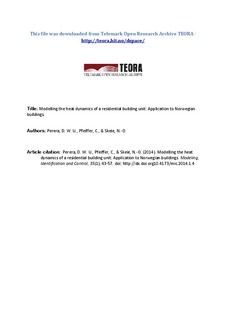| dc.contributor.author | Perera, Degurunnehalage Wathsala U. | |
| dc.contributor.author | Pfeiffer, Carlos Fernando | |
| dc.contributor.author | Skeie, Nils-Olav | |
| dc.date.accessioned | 2014-12-17T12:27:05Z | |
| dc.date.accessioned | 2017-04-19T12:50:00Z | |
| dc.date.available | 2014-12-17T12:27:05Z | |
| dc.date.available | 2017-04-19T12:50:00Z | |
| dc.date.issued | 2014 | |
| dc.identifier.citation | Perera, D. W. U., Pfeiffer, C., & Skeie, N.-O. (2014). Modelling the heat dynamics of a residential building unit: Application to Norwegian buildings. Modeling, Identification and Control, 35(1), 43-57. doi: http://dx.doi.org10.4173/mic.2014.1.4 | |
| dc.identifier.issn | 2076-2909 | |
| dc.identifier.uri | http://hdl.handle.net/11250/2438438 | |
| dc.description.abstract | The paper refers to the development of a continuous time mathematical heating model for a building unit based on the rst principles. The model is described in terms of the state space variables, and a lumped parameter approach is used to represent the room air temperature and air density using mass and energy balances. The one-dimensional heat equation in cartesian coordinates and spherical coordinates is discretized in order to describe the thermic characteristics of the layers of the building framework and furniture respectively. The developed model is implemented in a MATLAB environment, and mainly a theoretical approach is used to validate it for a residential building unit. Model is also validated using experimental data for a limited period. Short term simulations are used to test the energy e ciency of the building unit with regard to factors such as the operation of heat sources, ventilation, occupancy patterns of people, weather conditions, features of the building structure and heat recovery. The results are consistent and are obtained considerably fast, implying that the model can be used further in modelling the heating dynamics of complex architectural designs and in control applications. | |
| dc.language.iso | eng | |
| dc.publisher | Norwegian Society of Automatic Control | |
| dc.rights.uri | http://creativecommons.org/licenses/by/3.0 | |
| dc.subject | Heating model | |
| dc.subject | Heat recovery | |
| dc.subject | Power consumption | |
| dc.subject | Residential building unit | |
| dc.subject | Ventilation | |
| dc.title | Modelling the heat dynamics of a residential building unit: Application to Norwegian buildings. | |
| dc.type | Journal article | |
| dc.type | Peer reviewed | |
| dc.description.version | Published version | |
| dc.rights.holder | © 2014 Norwegian Society of Automatic Control | |
| dc.subject.nsi | 610 | |
| dc.identifier.doi | http://dx.doi.org/10.4173/mic.2014.1.4 | |

